The new 2013 Dodge Dart was in some ways nothing like the original, and in other ways everything like it... but it would only last until 2016.
Dodge unveiled their new compact sedan, the Dart, at the 2012 Detroit Auto Show. It was not just their first compact sedan since the Neon; it was the first Chrysler-brand product based on a Fiat architecture, adapted as it was from the Alfa Romeo Giulietta hatchback (C-EVO).
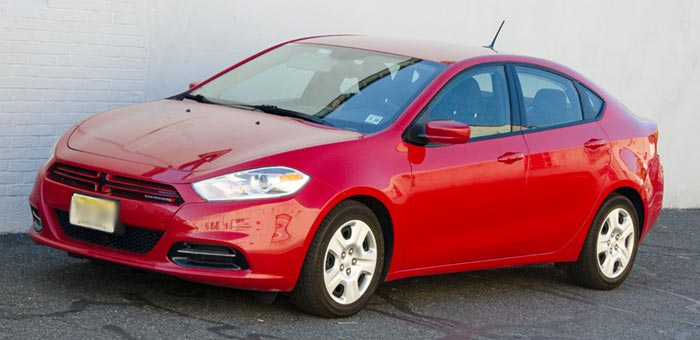
The new platform/architecture, CUSW (“Compact US Wide”), would underpin a whole range of vehicles—the Dart, a new Chrysler 200, a new Jeep Cherokee (coded KL), and even a future minivan (Pacifica). This decision had some good points, and some downsides. More money was invested into the engineering, but because the company was also creating the Cherokee and Chrysler 200 at the same time, the Dart was much wider and longer than most compacts. It ended up being on the verge of mid-sized; the extra size brought weight which hurt its ability to compete in either fuel economy or speed.
CUSW was a state-of-the-art architecture, and the Dart had a rigid structure thanks to the use of high-strength steel, which made up 68% of the body. It also had a four-wheel independent suspension and performance-tuned steering to deliver a more engaging driving experience than most cars in its class.
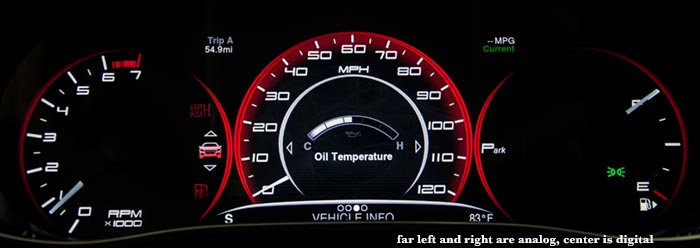
Dodge claimed the Dart had the spaciousness of a midsize car with the footprint of a compact sedan. Two then-unusual options were the third-generation Uconnect 8.4” infotainment system and a 7” “customizable dashboard” (gauge cluster display) that included a well-done digital analog speedometer. Dodge touted the ambient lighting, soft-touch materials, and creative storage spaces.
The front end debuted Dodge’s new “bandit” style which would soon be found on the refreshed 2015 Charger; at the rear, Dodge’s usual “racetrack” LED tail lamp array was on display on some models, but not all of them; the low-end Aero fuel-economy king has the racetracks, while the base SE and some SXTs did not.
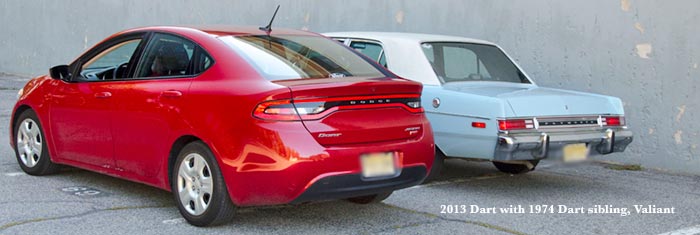
Lest anyone forget, the original Dart was “more different” from existing Chrysler Corporation cars, due largely to the skunkworks-style team that developed it; the torsion-bar suspension and axles were very different from other corporate vehicles, and the engine was created specifically for that one car; the corporate transmission was modified to fit. In contrast, the 2013 Dart was a full-bore corporate effort, but used three existing engines and transmissions.
Unlike most cars, the Dart’s personality changed quite a bit when going between powertrains, despite having little differences in power.
The 2.0L “Tigershark” and 2.4L “Tigershark” MultiAir four-cylinder engines were straight out of corporate parts bins, while the 1.4L MultiAir Intercooled Turbo “FIRE” engine came from the Fiat 500 Abarth. The MultiAir technology on two of these engines uses solenoids and fuel pressure to vary valve timing and lift on each individual cylinder; the company said it increased torque at low RPMs by up to 15 percent, with a 7.5 percent improvement in gas mileage. The 1.4 was matched with a special dual dry clutch automatic transmission when buyers didn’t want the Fiat manual; the Chrysler engines had a choice of Fiat manual or conventional automatic.
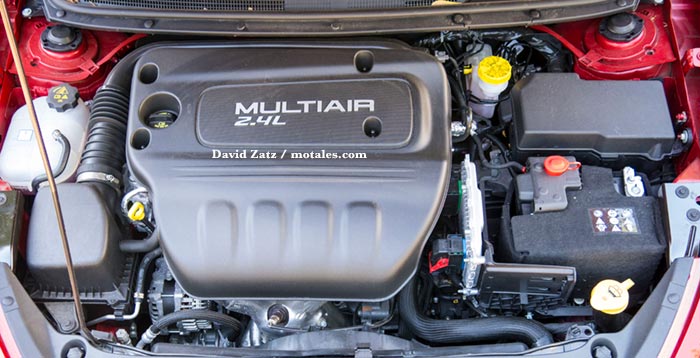
The Chrysler 2.0 and 2.4 liter “WGE” engines had blocks originally developed by Hyundai; from there they were modified by Mercedes, Chrysler, and Mitsubishi engineers, and dressed differently by Hyundai, Mitsubishi, and Chrysler.
The base engine was responsive, due partly to an aggressive throttle curve, but had limited power and economy. The 2.4 felt better but not quite there, and economy suffered with the big four-cylinder. On paper, Fiat’s 1.4 turbo was absolutely the best of the group, but it was a troublesome engine, especially in the 2013s. The 2013 Dart buyers could expect early failure of either the manual or dual-dry-clutch automatic transmission, for various reasons; the 2013s had high failure rates in the clutch, throwout bearing, and even the gearbox, and that was if you could get the turbocharger to last long enough for the transmission to fail first. Mistuning of many of these cars meant that they were only responsive when over 2,000 to 2,400 rpm. Owners quickly shared methods for retuning the turbocharger wastegate, resulting in much better low-rpm responsiveness.
The transmissions were another story. The DDCT was easy enough to drive; a crawl mode was added for Americans, which engaged the transmission at idle so the car would move slowly along like a traditional automatic (sometimes shaking a little as it did so). The DDCT felt good to some owners, unnatural to others; but the reliability was not as good as it should have been. The American engines came with normal automatics which had decent reliability. The Fiat manual transmissions, according to many owners, suffered mainly because of a valve placed in the system to avoid problems from inexperienced drivers. Without that valve, the cars shifted more predictably and the clutch lasted longer.
The 1.4 liter engine added around $1,300 to the price, and the DDCT automatic added $1,100 more. The base configuration was the 2.0 and manual transmission. The fastest 0-60 times, other than with the GT, came with the manual transmission and Fiat engine, with 0-60 in the low 7s. The 0-60 with the 1.4 and DDCT took around 8.2 seconds.
The Dart GT, despite only marginally higher power ratings, was better for enthusiastic drivers due to aggressive gearing, but that hurt gas mileage. No wide-ratio manual transmission was available.
The ride was quite good except in the chopped Aeros, which suffered from steel wheels and stiffer suspensions. While the Aero presumably held a handling edge, it was also noisy and prone to squeaks and rattles inside, along with window air leaks. It remains the lowest-resale-value Dart of the group.
Normal Darts from SXT on up had aluminum wheels and a great deal of sound insulation, providing quite good ride and handling with very low noise—among the quietest interiors in the class. The four wheel independent suspension and stiff body were helpful in hard cornering, especially with bumps or dirt in the road. Wet weather and snow handling were both good. Braking was quite good but since Chrysler had adopted Fiat’s brake feel, also quite disturbing to people driving a Dart or new Chrysler for the first time; the brakes were grabby at first rather than smoothly building stopping pressure.
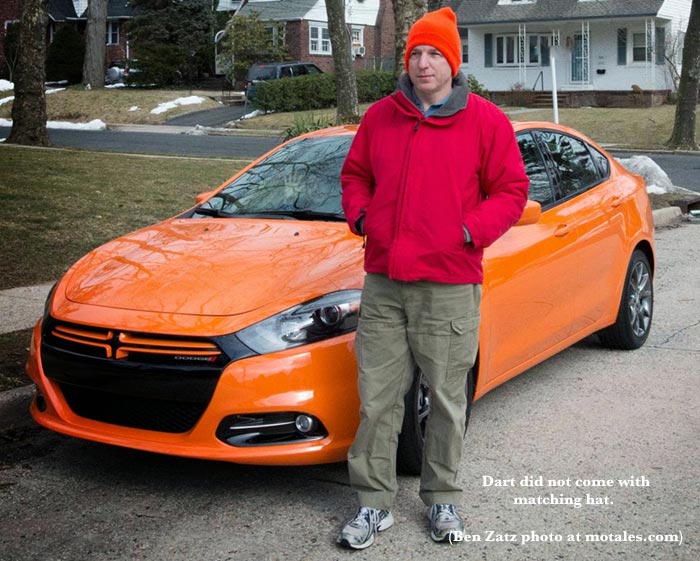
The Dart was quiet and composed over harsh surfaces, and rewarding to drive in pretty much any situation. The stereo was quite good as well, compared to other stock units, both easy to use and having good speakers and control. The USB access allowed for thumb drives up to 128GB, and quickly memorized their contents; it played back in album order if desired. The three-way tone control allowed for choices of bass, midrange, and treble. The only real flaw was not ignoring Mac resource forks, and not having bass/treble knobs. (The HVAC system’s flaw was using pushbuttons for heat control unless you got the thermostatic system.)
Wheel mounted audio controls were standard on most trim levels.
The 2013 Dart was originally available in five trim levels: SE, SXT, Rallye, Limited, and R/T (which came to production as the GT), with the base MSRP beginning at $15,995 before a $795 destination charge.
The base 2013 Dart SE was powered by the 2.0L Tigershark 4-cylinder engine, producing 160 horsepower and 148 lb-ft of torque. This engine was matched to a 6-speed manual transmission, and a 6-speed automatic was optional. Standard features included LED tail lamps, projector halogen headlights, an acoustic laminated windshield, manual driver’s seat, “Denim” cloth seats, and power windows. Steel wheels were included, harshening the ride.
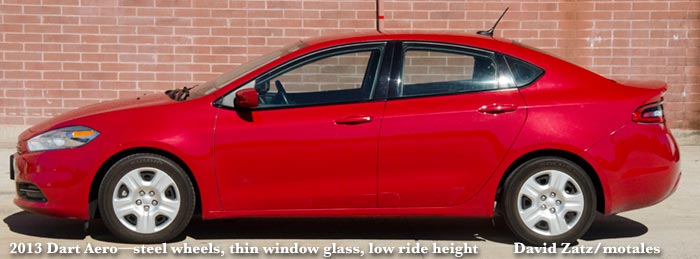
The Aero version of the SE kept the steel wheels but swapped in a 1.4 liter turbocharged Fiat engine, boasting 160 horsepower and 184 pound-feet of torque; with the stick it would reach 42 mpg, EPA highway. It came with the “racetrack” rear lights, automatic grille shutters for extra aero, and an aerodynamic lower body pan, made of heavy plastic, with removable panels for maintenance and repairs. The 8.4 stereo and digital dash were optional. Other items of note were lightweight aluminum chassis pieces, a lower ride height (which could cause scraping on ramps), low rolling resistance tires, and non-acoustic window glass, which saved weight but could cause whistling and made the interior noisier than in any other Dart. The Aero was destined to have rather lower resale value than any of the others.

The Dart SXT built on the equipment offered in the SE by adding 17” aluminum wheels, power body-colored mirrors and door locks, keyless entry, a six speaker sound system, security alarm, and air conditioning with a micron filter. The SXT had an options roster that included the 8.4” Uconnect system, back-up camera, sunroof, and premium sound system, among other items.
The Dart Rallye was based on the SXT, but added a black front fascia accent, black headlight bezels, projector fog lights, dual exhaust, and a leather wrapped steering wheel with integrated audio controls. The Rallye could be spec’ed with the 1.4L MultiAir turbocharged 4-cylinder that had 160 horsepower (the same as the base 2.0L) and 184 lb-ft of torque (an increase of 36 lb-ft over the base engine).
The Dart Limited was the luxury-focused trim level. Like the Rallye, it was based on the SE but added bright door handles and grille, the 8.4” Uconnect touch screen, back-up camera, a 7” gauge cluster display, power driver seat, automatic headlights, stitching on the instrument panel, and projector fog lights. Optional equipment included Nappa leather, heated steering wheel, Garmin navigation, polished aluminum wheels, and rear cross path detection.
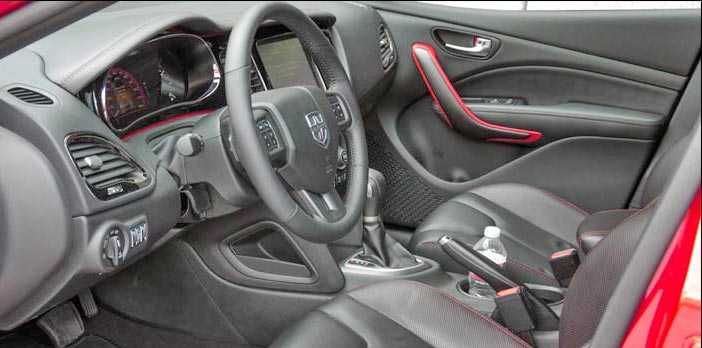
The top trim level, which early releases dubbed the R/T, was to be based on the Limited, but added 18” wheels, a sport-tuned suspension with frequency-sensing damping shocks, a unique front fascia with black accents, black headlight bezels, dual exhaust tips, perforated Nappa leather seats, dual zone climate control, heated seats, and a heated steering wheel. When it came to production later in the model year, it was called the GT, not the R/T. Options on the GT included Keyless Enter ‘n Go, HID headlights, and a premium sound system. There was no extra power with the R/T; it was geared aggressively, so 0-60 times were faster, but the gas mileage and highway noise were worse.
Dodge also added two “Special Edition” packages and a Rallye Appearance Group to the Dart later in the 2013 model year. The Special Edition packages could be added to the SXT and Limited. On the SXT, the Special Edition package included a black cross hair grille, projector fog lights, leather wrapped steering wheel, cruise control, LED tail lamps, dual exhaust, and a storage bin that could be accessed by lifting up the front passenger seat cushion. On the Limited, the Special Edition package added a sunroof, heated seats and steering wheel, two-zone climate control, satellite radio, LED tail lamps, and Garmin navigation. The Rallye appearance group was available only on the SXT and included a black front fascia accent, Rallye badge, and black aluminum wheels.
After its introduction with a slew of trim levels and packages, Dodge simplified the Dart lineup for 2014 with five models—SE, SXT, Aero, Limited, and GT. The 2.4L 4-cylinder became standard on the SXT, Limited, and GT. The SE continued to be powered by the 2.0L engine and the Aero was still powered by the 1.4L 4-cylinder. A Blacktop package for the Dart SXT added black wheels, black side mirrors, and unique interior accents.
Most or all of the 2013 1.4 liter engines did not have the turbo wastegate adjusted at the factory; the 2014s did, and reportedly had numerous other updates for greater reliability and drivability. Generally the 2013s are not the best bets for used cars, and the 2014s are better choices.
For 2015, the 2.4L engine got a few updates to become a Partial Zero Emission Vehicle (PZEV). These updates included a new fuel filler neck, air cleaner, engine downpipe, updated fuel tank, updated vapor purge canister, and new fuel cap. The base SE added new standard features: air conditioning, Bluetooth, cruise control, and power equipment.
Dodge added a new Sport Appearance Hood which was available with the Rallye or Blacktop packages on the SXT, or on the GT. A Rallye Appearance Group became available for the SE, adding black accents on the front end and 17” Granite Crystal wheels. The Blacktop package became available on the GT and the GT also added a standard 18” Hyper Black wheel.
Later in the 2016 model year, Dodge simplified the Dart to three trim levels: SXT Sport, Turbo, and GT Sport. This lineup might have been more sensible than the complicated one they started with on the 2013 cars. On each one, the manual transmission was standard and an automatic was optional.
The SXT Sport, like the old SE, was powered by the 2.0L 4-cylinder and had cruise control, keyless entry, Bluetooth, satellite radio, steering wheel mounted audio controls, and aluminum wheels.
The Turbo was powered by the 1.4L MultiAir 4-cylinder and came with the sport appearance hood, dual exhaust, and 17” Granite Crystal wheels.
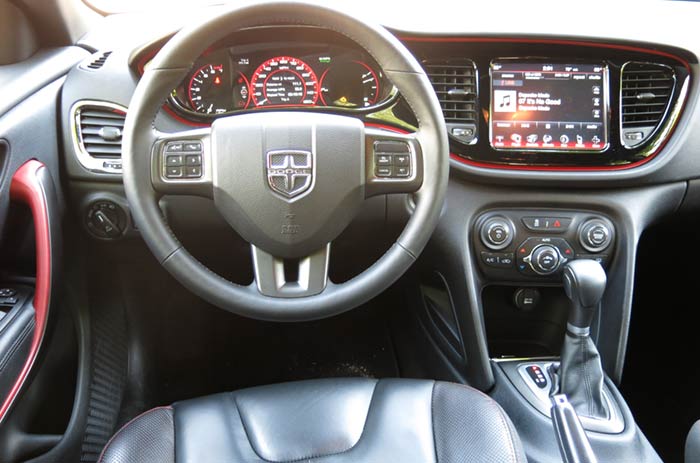
The GT Sport was powered by the 2.4L 4-cylinder engine, with the sport appearance hood, performance gear ratios, unique engine calibration, Keyless Enter ‘n Go with push button start, 17” Granite Crystal aluminum wheels, dual exhaust, a black front fascia accent piece, power driver’s seat, 8.4” Uconnect touch screen, 7” gauge cluster display, back-up camera, dual zone climate control, and power-heated exterior mirrors.
Three primary “customization” packages were available on the SXT Sport, which was the volume model.
The Dart was a unique package in the compact line, providing the quietest interior in the class (if you didn’t get an Aero), an enviable combination of size, acceleration, and economy (if you got the Fiat engine and manual transmission), high comfort, a surprisingly well outfitted interior (especially with the 8.4 screen and customizable dashboard), and a good combination of cornering and ride.
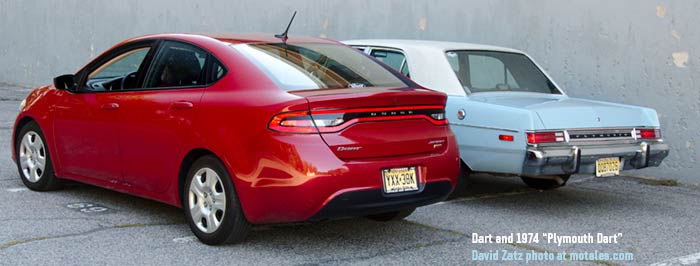
What killed the Dart? Chances are it was the poor quality and tuning of the 2013s with the Fiat engines, as well as the poor economy of the models with the 2.4 engine. Dodge never overcame the disappointing sales, never invested in an SRT or serious R/T version (they had done a Caliber SRT4 which would be a good starting point), or showed much interest after the launch. The three-engine strategy was a little odd, given that they were fairly similar in power, particularly the 1.4 turbo and the 2.4, and Fiat’s apparent refusal to do a wide-ratio version of their manual transmission meant that to have better launches, Dodge had to give up highway mileage.
Looking at the Aero, the car made to reach 41 mpg (highway), there were also issues. It did not have the acoustic glass of the other models, and the body was lowered somewhat clumsily, so that the front scraped on relatively minor ramps; ride and noise were both higher than they should have been. As if to make up for it, the cars came with the fully lit “racetrack” tail-lamps. The Aero also had no engine cover, no spare tire, and despite the tighter springs, steel wheels which also hurt the ride compared to the aluminum rims of the SXT and higher models.
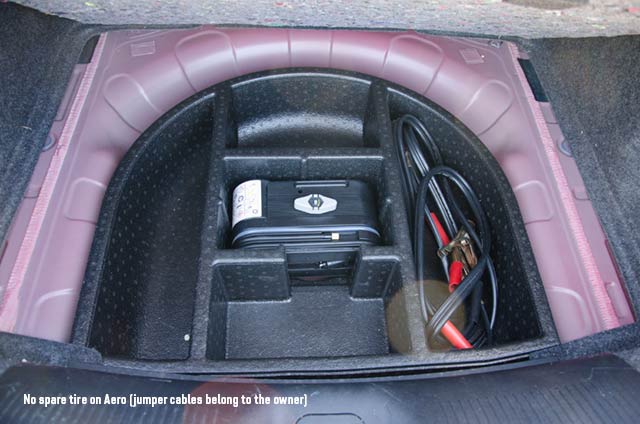
Too much sharing with the Cherokee likely contributed to its weight, which hurt acceleration and economy, but it was still a reasonably good package—given the right marketing and perhaps a higher-performance model for street cred, e.g. a 250-horsepower R/T using a mild turbocharger based on the old Caliber SRT4 engine (which had reached 285 horsepower). Oddly enough, an SRT model was all but promised, and remained a strong rumor for around two years after the Dart was launched. A low-pressure turbocharger for the 2.4 might have boosted output to 220 horsepower or so, providing better acceleration without the need for a performance axle ratio.
The Dart went on sale in 2012, but its first full year was 2013, during which it racked up 83,388 sales—less than a quarter of the Corolla’s, and, more important, well below the 100,000 needed for breakeven on a dedicated assembly line. The cars were much more refined and reliable with the 2014 model year, but the damage was done; sales only reached 83,858, with a stone’s throw of 2013. The 2015 model year was better, with 87,908 sales, but still well below 100,000.

In January, 2016, the Dodge Dart and Chrysler 200 were discontinued. The company stated that this was to refocus on crossovers, which had seen a dramatic boom in popularity over the preceding years; but FCA would have to make hefty payments to Tesla for emissions credits without their higher-mileage cars. Some believe the Dart was dropped due to its warranty costs with the Fiat powertrain. In any case, given flexible manufacturing and the similarity of the three cars, they could all have been made on the same line as the Cherokee—and many at FCA probably wished they had taken that step instead of paying more to Tesla for emissions credits.
Dodge sold 43,402 Darts in the US during calendar-year 2016, and handfuls every year after that, into 2021.
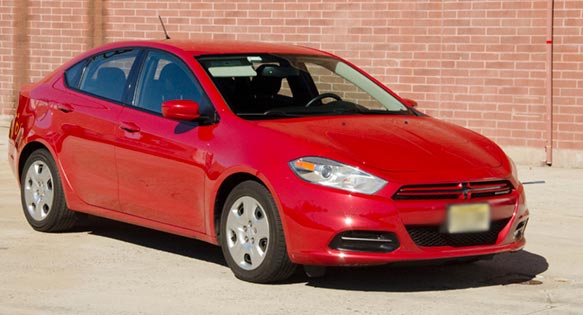
The late Sergio Marchionne, then CEO of FCA, stated that the Dart and 200 “were the least financially rewarding enterprises that we’ve carried out inside FCA in the last eight years.” With the 200, which replaced a cheaper-to-build car without gaining any sales, that was most likely quite accurate; but it’s hard to tell how bad the Dart was, financially, given that some of its cost would have been spent on the Cherokee and 200 regardless, and that its sales did reduce FCA’s emissions-credit costs. In any case, the Dart spent quite a bit of time with abysmal resale values before, in the car shortage of 2021, recovering most of the lost value. Suddenly, Darts didn’t look so bad; and many owners remain quite fond of them.
Ryan Dodd had an obsession with cars from a young age, reading NADA books and sketching cars in elementary school. He has since moved on to creating renderings in Photoshop and writing about auto news for AutoBison.
For more information, see Dart-Mouth.com (unrelated site).
Copyright © 2021-2025 Zatz LLC • Chrysler / Mopar car stories and history.
YouTube • Editorial Guidelines • Videos
Tailfins Archive • MoTales on BlueSky